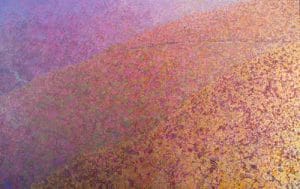
In an interview with Laurie Thomas in 1969 Robert Juniper said, “I think it is a painter’s duty if not his goal to be himself – to paint from his own experience, what’s inside him and not from the glossy magazines.” Thomas considered that Juniper had a poetic feeling for the Australian landscape, though Juniper considered that his interest was more localised than the broader description of Australia. “I feel that I’m developing what I feel is an indigenous thing – indigenous to Western Australia – because I don’t feel any strong influence from anywhere else,”
Juniper was accurate in his self assessment. His work is free from the outside influence of others though his influence on others is recognized. If anyone could lay claim to having an effect on his work, it was probably Sam Fullbrook. On his initial exposure to Fullbrook’s paintings Juniper would say “Fullbrook’s paintings then pulsated with the heat of the north and showed me for the first time a vision beyond the verdant rim, that hot gut of the Australian landscape.” He was to put Fullbrook’s colour guide into sound use though he was never to embrace his glissando technique of painting. Juniper was much more enthused about texture and paint quality to restrict himself to colour unaided.
Moonrise over Gwalia is a major example of Juniper’s unique interpretation of the Western Australian landscape. It is an exotic image that can revive the memories of people that have lived and worked within the region and satisfy the yearnings of those that haven’t made the journey. This is a personal and romantic record of his visit to Gwalia. A quiet time at a bewitching hour as his companion and his Rhodesian Ridgebacks wander quietly among the ruins of the once prosperous town.
The full moon rises and casts subtle shadows across the land, the middle distance takes on the glow of reflected moonlight as the sun retreats below the horizon. Juniper’s colours imitate the hour and to add the personal touch, he introduces himself into the composition with his trademark Stetson and Cuban heeled boot.
The viewer is in no doubt that Juniper has experienced this scene and recreated the memory in his unique style.












